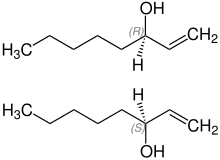1-辛烯-3-醇
外观
| 1-辛烯-3-醇 | |
|---|---|

| |
| IUPAC名 Oct-1-en-3-ol | |
| 别名 | 蘑菇醇 松茸醇 |
| 识别 | |
| CAS号 | 3391-86-4 3687-48-7((R)-(–)) 24587-53-9((S)-(+)) |
| PubChem | 18827 |
| ChemSpider | 17778 |
| SMILES |
|
| InChI |
|
| InChIKey | VSMOENVRRABVKN-UHFFFAOYAB |
| ChEBI | 34118 |
| KEGG | C14272 |
| 性质 | |
| 化学式 | C8H16O |
| 摩尔质量 | 128.21 g·mol−1 |
| 若非注明,所有数据均出自标准状态(25 ℃,100 kPa)下。 | |
1-辛烯-3-醇,也称为蘑菇醇,[1]是一种能吸引蚊子等叮咬昆虫的化学物质,化学式为C8H16O。它包含在人类的呼吸和汗液中,据信驱虫剂避蚊胺通过阻断昆虫的1-辛烯-3-醇气味受体发挥作用。[2][3][4]
自然发现
[编辑]1-辛烯-3-醇由多种植物和真菌产生,包括食用菌和香蜂花等。1-辛烯-3-醇在亚油酸氧化分解过程中形成。[5]
性质
[编辑]
1-辛烯-3-醇是衍生自1-辛烯的二级醇。它以两种对映体,(R)-(–)-1-辛烯-3-醇和(S)-(+)-1-辛烯-3-醇的形式存在。
合成
[编辑]1-辛烯-3-酮的两种可能的实验室合成为:[6]
在生物化学中,1-辛烯-3醇是从亚油酸的脂质过氧化,由脂氧合酶催化,然后通过氢过氧化物裂解酶的帮助下产生。该反应发生在奶酪中,在生物技术中用于产生(R)-异构体。[7][8]

用途
[编辑]1-辛烯-3-醇有时与二氧化碳结合使用来吸引昆虫,以便用某些设备杀死它们。[9]
使用“蘑菇醇”这个名称是因为1-辛烯-3-醇是蘑菇的主要风味成分。[10]
健康和安全
[编辑]1-辛烯-3-醇已被美国食品和药物管理局批准为食品添加剂。[11]它具有中等毒性,LD50为340 mg/kg。[9]
在一项动物研究中,已发现1-辛烯-3-醇会破坏多巴胺体内平衡,并且可能是一种与帕金森氏症有关的环境因素。[12]
参见
[编辑]参考资料
[编辑]- ^ 1-Octen-3-ol, Mushroom alcohol. [2019-08-29]. (原始内容存档于2020-11-24).
- ^ Petherick A. How DEET jams insects' smell sensors. Nature News. 2008-03-13. doi:10.1038/news.2008.672. (原始内容存档于15 March 2008).
- ^ Ditzen M, Pellegrino M, Vosshall LB. Insect odorant receptors are molecular targets of the insect repellent DEET. Science. March 2008, 319 (5871): 1838–42. Bibcode:2008Sci...319.1838D. PMID 18339904. S2CID 18499590. doi:10.1126/science.1153121.
- ^ Syed Z, Leal WS. Mosquitoes smell and avoid the insect repellent DEET. Proceedings of the National Academy of Sciences of the United States of America. September 2008, 105 (36): 13598–603. PMC 2518096
 . PMID 18711137. doi:10.1073/pnas.0805312105
. PMID 18711137. doi:10.1073/pnas.0805312105  .
.
- ^ Chemical properties of attractants. [2010-06-08]. (原始内容存档于2009-04-27).
- ^ Wnuk, S.; Kinastowski, S.; Kamiński, E. Synthesis and analysis of 1-octen-3-ol, the main flavour component of mushrooms. Die Nahrung. 1983, 27 (5): 479–486 [2022-12-31]. ISSN 0027-769X. PMID 6684212. doi:10.1002/food.19830270523. (原始内容存档于2022-12-31).
- ^ Matsui, Kenji; Sasahara, Satomi; Akakabe, Yoshihiko; Kajiwara, Tadahiko. Linoleic acid 10-hydroperoxide as an intermediate during formation of 1-octen-3-ol from linoleic acid in Lentinus decadetes. Bioscience, Biotechnology, and Biochemistry. 2003, 67 (10): 2280–2282 [2022-12-31]. ISSN 0916-8451. PMID 14586122. S2CID 46173472. doi:10.1271/bbb.67.2280. (原始内容存档于2022-12-31).
- ^ Lipid biotechnology. Tsung Min Kuo, Harold W. Gardner. New York: Marcel Dekker. 2002. ISBN 0-585-40371-6. OCLC 48691412.
- ^ 9.0 9.1 Biopesticides Fact Sheet for Octenol (PDF). EPA fact sheet. 2007-07-05 [2022-06-28]. (原始内容存档 (PDF)于2021-12-17).
- ^ 1-octen-3-ol. thegoodscentscompany.com. [2015-05-31]. (原始内容存档于2022-12-26).
- ^ US FDAs Center for Food Safety and Applied Nutrition. US FDA/CFSAN – EAFUS List. [2008-03-16]. (原始内容存档于2008-02-21).
- ^ Inamdar AA, Hossain MM, Bernstein AI, Miller GW, Richardson JR, Bennett JW. Fungal-derived semiochemical 1-octen-3-ol disrupts dopamine packaging and causes neurodegeneration. Proceedings of the National Academy of Sciences of the United States of America. November 2013, 110 (48): 19561–6. Bibcode:2013PNAS..11019561I. PMC 3845153
 . PMID 24218591. doi:10.1073/pnas.1318830110
. PMID 24218591. doi:10.1073/pnas.1318830110  .
.
